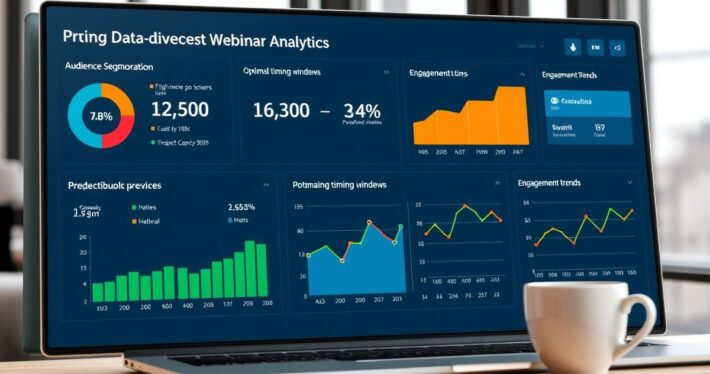Real-time audience engagement feedback with AI tools.

Introduction: Why Real-Time Feedback is a Game-Changer for Webinars
Let’s face it—hosting a webinar can feel like speaking into a void. Are your attendees actually engaged? Are they nodding along or scrolling through their Instagram feed? The truth is, without real-time audience engagement feedback, you’re flying blind. Enter AI tools, the modern-day superheroes of webinar hosting. These tools don’t just guess—they analyze, measure, and deliver actionable insights in real time, helping you pivot and adapt on the fly.
But here’s the kicker: Real-time feedback isn’t just about keeping your audience awake (though that’s important). It’s about understanding their needs, answering their questions, and ultimately driving them toward that all-important “Yes.” Ready to dive in? Let’s explore how AI tools are revolutionizing the way we engage with webinar audiences.
What Makes Real-Time Feedback So Powerful?
Imagine you’re delivering a webinar on “AI Marketing Strategies.” Midway through, you notice a dip in engagement. Maybe your audience is confused, bored, or just zoned out. Without real-time feedback, you’d have no idea what’s happening or how to fix it. But with AI tools, you can instantly:
- Measure audience sentiment (are they excited, confused, or indifferent?).
- Track attention spans (are they sticking around or tuning out?).
- Identify key pain points (what questions or concerns are they typing in the chat?).
This isn’t just data—it’s actionable intelligence. Think of it as having a co-pilot who constantly whispers, “Speed up here,” “Slow down there,” or “Explain that again.” It’s the ultimate cheat code for delivering a high-converting webinar.
Key AI Tools for Real-Time Engagement Feedback
Not all AI tools are created equal. Here’s a breakdown of the most effective solutions for real-time feedback:
1. Sentiment Analysis Tools
These tools analyze audience behavior—like chat messages, facial expressions (via video), or even typing speed—to gauge emotional responses. For example, if the chat is filled with question marks or “Huh?” messages, you’ll know it’s time to clarify your points.
Pro Tip: Use sentiment analysis to identify “lightbulb moments” when your audience connects with your message.
2. Attention Tracking Systems
AI-powered attention trackers monitor how long attendees stay focused on your content. If attention starts to wane, these tools can alert you to introduce a poll, share a story, or switch up your delivery style.
Real-World Example: One webinar host noticed a 20% drop in attention during a technical segment. By adding a quick Q&A break, they regained focus and boosted overall engagement.
3. Interactive Q&A Platforms
These platforms use AI to prioritize audience questions based on relevance and urgency. Instead of sifting through hundreds of messages, you can address the most pressing concerns in real time.
Challenge: Avoid overloading your audience with too many questions. Use AI to curate the best ones.
4. Live Polling and Surveys
AI-enhanced polling tools allow you to create dynamic, in-webinar polls that adapt based on audience responses. For instance, if 80% of attendees say they’re struggling with a specific topic, you can dive deeper into that area.
Fun Fact: Live polls can increase audience retention by up to 40%. Why? Because they make attendees feel heard.
How to Use Real-Time Feedback to Boost Conversions
Here’s where the magic happens. Real-time feedback isn’t just about engagement—it’s about driving action. Here’s how to use it to your advantage:
1. Identify Pain Points Before the Pitch
If your audience is confused or overwhelmed, they’re unlikely to buy. Use AI tools to spot these issues early and address them before you present your offer.
Example: During a sales webinar, an AI tool flagged confusion around pricing. The host clarified the value proposition, and conversions skyrocketed.
2. Personalize Your Delivery
AI tools can segment your audience based on their behavior and preferences. For instance, if half your attendees are beginners and the other half are advanced, you can tailor your content to meet both needs.
Pro Tip: Use AI to create customized call-to-actions (CTAs) that resonate with different audience segments.
3. Create Urgency with Data
Real-time feedback can reveal when your audience is most engaged. Use this moment to introduce your offer or bonus.
Example: An AI tool detected peak engagement during a case study presentation. The host used this moment to unveil a limited-time discount, resulting in a 50% increase in sales.
Overcoming Challenges with Real-Time Feedback
While AI tools are powerful, they’re not without their challenges. Here are some common pitfalls and how to avoid them:
1. Data Overload
Too much feedback can be overwhelming. Focus on the metrics that matter most, like attention span and sentiment.
2. Privacy Concerns
Be transparent about how you’re collecting and using audience data. Provide opt-out options and ensure compliance with privacy regulations.
3. Over-Reliance on AI
AI is a tool, not a replacement for human intuition. Use it to enhance—not dictate—your delivery.
Conclusion: The Future of Webinars is Real-Time Engagement
So, what’s the bottom line? Real-time audience engagement feedback with AI tools isn’t just a nice-to-have—it’s a must-have for anyone serious about webinar success. Whether you’re hosting a sales pitch, a training session, or a thought leadership webinar, these tools give you the insights you need to connect with your audience on a deeper level.
Ready to take your webinars to the next level? Start experimenting with AI tools today and watch your engagement (and conversions) soar.



